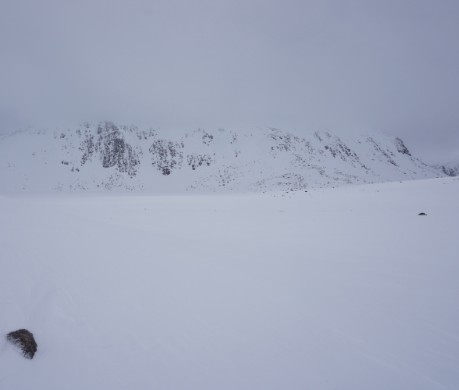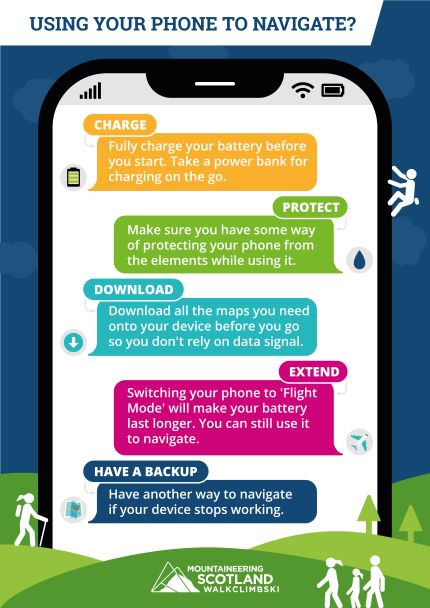Regardless of what equipment you use to follow your route, it's important that you are able to understand what the terrain will be like, choose suitable routes and be able to make decisions about changing your route if you need to. For example, in the winter, there may be a dangerous cornice where a summer route runs close to the edge of the cliffs above a corrie.
Plans may also change, the weather may
close in, heavy rain might mean that a burn won't be crossable, or there
may be an accident. All such eventualities can’t be pre-programmed into a
GPS, so learning the skills to be able to look at the map and understand it – whether on paper
or a screen – will mean you can work out the best way to adjust any route to deal
with changing situations.
In essence, navigation is navigation, regardless of the season. But in winter you have to be much more precise because your route planning will have to reflect any hazards including steep ground and possible avalanche risk in some areas which would present no problem in summer, and it is likely that snow will blot out much of the detail in the landscape, making following your route that much more challenging.
In the photo here not only a well-trodden footpath, but also a whole loch have disappeared under the snow. There may be a trail of footprints on the snow, but these can quickly disappear in heavy snow or wind.
Where in summer you may use streams, walls or other small features as something to aim for, a covering of snow in winter means these may be harder to see or even completely covered. You will often have to use larger scale landscape features such as cols, ring contours and ridges instead and learning techniques such as timing and pace counting can be really helpful to gauge the distance you have walked in navigation stages.
Steepness of terrain also becomes more important in winter as snow may accumulate and create a risk of avalanche – particularly if the slope angle reaches around 30 degrees. It's worth finding out more about gauging slope angle from the map and from missing contour lines.
And if you DO lose track of where you are... don't panic. This can be serious in winter conditions, but even without GPS or other electronic navigation aids, as long as you have a map and compass there are several relocation strategies you can use to retrieve the situation.
Many people choose to use electronic devices for navigation, especially for being able to check your location in poor visibility - read more below about how to make the best use of them.

GPS devices and smartphones are increasingly being used for navigation in the mountains. Many devices will let you pre-plot a route using mapping software on your PC (such as Memory Map, Anquet etc.), or download a prepared route from elsewhere, such as the Walkhighlands website. The line of the pre-planned route can then be shown on the screen.
It sounds the ideal solution for finding your way safely about the hills, but it’s important to realise there are limitations to technology and that safe navigation involves the skills to read and interpret a map rather than just following an arrow. Mountain rescue teams respond to many call-outs because of GPS/smartphone failure, inappropriate route choice or because people are unable to use the technology effectively.

Here are some things to think about when using your phone in the mountains:
PROTECT – keep your phone in a waterproof case to protect it from the elements, even if it’s rated as waterproof, and keep it close to your body when not in use to keep it warm, dry and help battery life.
DOWNLOAD – download all the maps you might need so you don’t need to rely on mobile data to be able to access maps while you're on the hill. Include maps of the surrounding areas in case you need to change your route, and use a topographic map (eg OS or Harvey Maps) – not all digital maps are suitable for hiking in the hills! If you are planning to follow a route downloaded from an app or website, it's worth checking with other reliable sources of information to make sure it's safe and suitable for your level of experience and ability.
EXTEND - Switching your phone to ‘Flight Mode’ stops it talking to the outside world and makes your battery last a lot longer. The GPS will still work, so you can still navigate. Taking a ‘Power Bank’ and an appropriate cable to link your phone to it, will give you the option to re-charge on the go – this might not work in very wet conditions though!
TAKE A BACKUP - No system is 100% fail safe, so having a separate system to navigate with if the phone or GPS were to fail is a must, for example a map and compass, and a good level of skill to be able to use them. If your phone isn’t working and you can’t use it to navigate, it also means you can’t use it to phone for help either! Having a simple backup phone in the first aid kit with actual buttons and a battery that will last for 6 months switched off is something to consider too.